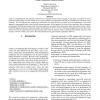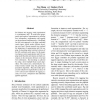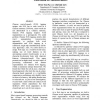265 search results - page 4 / 53 » Statistical-Based Approach to Word Segmentation |
COLING
2008
13 years 9 months ago
2008
Words in Chinese text are not naturally separated by delimiters, which poses a challenge to standard machine translation (MT) systems. In MT, the widely used approach is to apply ...
LREC
2010
13 years 9 months ago
2010
Arabic is a morphologically rich language, which presents a challenge for part of speech tagging. In this paper, we compare two novel methods for POS tagging of Arabic without the...
CAIP
2009
Springer
14 years 12 days ago
2009
Springer
Edit distance matching has been used in literature for word spotting with characters taken as primitives. The recognition rate however, is limited by the segmentation inconsistenci...
ACL
2008
13 years 9 months ago
2008
For Chinese POS tagging, word segmentation is a preliminary step. To avoid error propagation and improve segmentation by utilizing POS information, segmentation and tagging can be...
EMNLP
2004
13 years 9 months ago
2004
Chinese part-of-speech (POS) tagging assigns one POS tag to each word in a Chinese sentence. However, since words are not demarcated in a Chinese sentence, Chinese POS tagging req...



